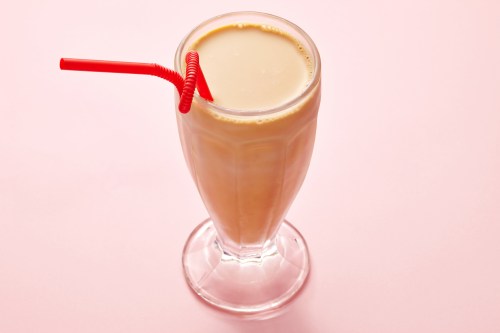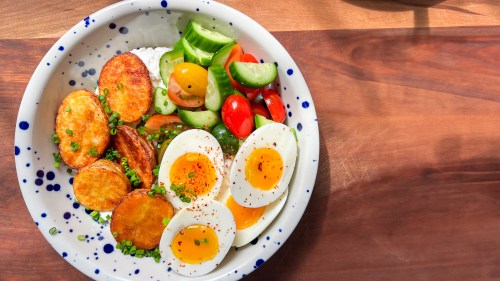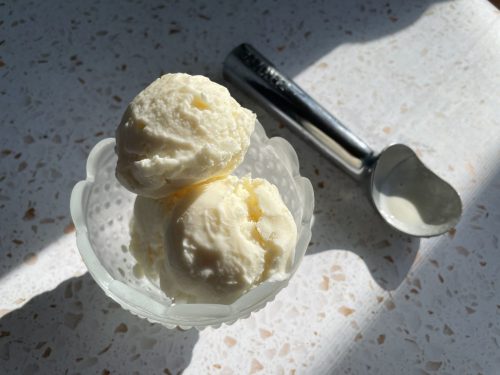Our editors independently select these products. Making a purchase through our links may earn Well+Good a commission
This Natural Sweetener May Improve Your Heart and Gut Health
Bonus: You probably already have it in your pantry.

Maple syrup, the beloved breakfast staple hailing from Canada is known for its rich flavor and naturally occurring sweetness. Many people favor it over more traditionally refined sugars, but can including maple syrup in your diet really provide health benefits? A recent study published in The Journal of Nutrition says yes—using maple syrup as a simple swap for more refined sugars can potentially improve heart and gut health.
In this article, we spoke with two registered dietitians to get the scoop on what makes maple syrup unique from a nutrition perspective, how much you should eat, how to spot the real stuff, and the best ways to add it to your diet—pancakes optional.
What are the health benefits of maple syrup?
The 2024 study in The Journal of Nutrition found that replacing refined sugar (sucrose syrup) intake with maple syrup led to lower blood sugar and blood pressure levels, reduced visceral fat (fat around the organs), and increased beneficial gut bacteria.
And that's not all. "Maple syrup has a lower glycemic index than sugar, so it won't spike your blood sugar levels as quickly," explains Kelsey Sackmann, MS, RD, owner of Kelsey P. RD. Plus, "the processing of maple syrup allows it to retain nutrients," she adds, "including manganese, riboflavin, zinc, magnesium, calcium, and potassium."
In fact, two tablespoons of maple syrup provide 50 percent of the daily value (DV) of manganese and 40 percent of the DV of riboflavin, says Sarah Alsing, MS, RD, sports and media dietitian and owner of Delightfully Fueled. "Manganese helps support protein, cholesterol, glucose, and carbohydrate metabolism," she explains, "and also plays a role in bone formation, reproduction, immune response, and blood clotting." And riboflavin (aka one of the B vitamins)? According to Alsing, it's involved in energy production, cell growth and development, and the metabolism of fats and carbohydrates.
Alsing notes that the focus of the study in The Journal of Nutrition was on replacing refined sugars with maple syrup—not simply adding more sugar to what people would normally eat.
How much maple syrup do you need to get these benefits?
Before you go pouring maple syrup onto all your food, it's important to understand how much is actually needed to glean any health benefits. "Study participants replaced 5 percent of their total calories from refined sugar with two tablespoons of maple syrup," explains Alsing. But she adds that while a little bit of maple syrup may be beneficial, too much sugar of any kind is not great for you. "The Dietary Guidelines for Americans recommends limiting added sugars to less than 10 percent of total calories," she says, "which includes maple syrup."
Alsing notes that the focus of the study in The Journal of Nutrition was on replacing refined sugars with maple syrup—not simply adding more sugar to what people would normally eat. However, while maple syrup is a source of sugar, Alsing suggests that it's a "smarter sweetener" because it provides some micronutrients and polyphenols that may benefit blood sugar, blood pressure, body fat, and gut health.
To minimize maple syrup's impact on your blood sugar levels, consider pairing it with a source of fiber (like oatmeal) or protein (like Greek yogurt), which slow down digestion and can limit blood sugar spikes.
How to spot real vs fake maple syrup
"Packaging can be deceiving," says Sackmann, "with some products advertised as 'maple flavor' or 'pancake syrup'." She adds that while these products may look similar, they're often high fructose corn syrup with maple flavoring and lack the health benefits of pure maple syrup.
Sackmann suggests looking for the words "pure" or "real" maple syrup on the label to ensure you're getting the antioxidants and minerals. Grade A maple syrup comes exclusively from the maple tree and is classified into four colors: Golden, Amber, Dark, and Very Dark. According to Sackmann, darker varieties tend to have more antioxidants and robust flavor than the lighter versions. Additionally, check the ingredient list, which should read: “100% pure tree sap.”
Ways to incorporate maple syrup
According to Alsing and Sackmann, there are many ways to replace your sugar intake with maple syrup. Here are some of their suggestions:
- Instead of sweetened yogurt, buy unsweetened and drizzle pure maple syrup to add your own sweetness
- Mix maple syrup into oatmeal for flavor
- Use maple syrup in place of white sugar when baking (substitute ¾ to 1 cup of maple syrup for every 1 cup of granulated white sugar)
- Add a small amount to enhance coffee's natural flavor (while also reducing bitterness)
- Coat vegetables like butternut squash, carrots, and Brussels sprouts with maple syrup before baking
- Use maple syrup as a glaze for salmon
If you're an athlete, Alsing adds that with its natural sugars, vitamins, and minerals, maple syrup is a great choice to fuel performance. "Maple syrup can be enjoyed pre-workout in oatmeal to add more easily digestible carbs to supply the body with energy," she explains. She also notes that it can be used during long workouts to provide a quick boost of energy. Here are some recipes athletes may enjoy:
Remember, it's more about substituting sources of refined sugar (like white table sugar or high fructose corn syrup) with maple syrup than it is about adding additional sugar in the form of maple syrup.
Final thoughts
Maple syrup offers some health perks, but like any sweetener, moderation is key. Choosing 100 percent pure maple syrup ensures you get the nutrients and rich flavor while enjoying the benefits of replacing refined sugar. It's easy to incorporate into your daily routine—drizzle it on yogurt, stir it into oatmeal, or use it in marinades and glazes for a naturally sweet touch.
Sign Up for Our Daily Newsletter
Get all the latest in wellness, trends, food, fitness, beauty, and more delivered right to your inbox.
Got it, you've been added to our email list.









